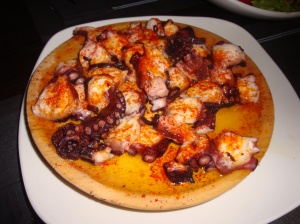Santiago de Compsotela, Spain is located north of Portugal and in the capital of the Galician region. Known for the Cathedral of St. James, it’s the end of the Camino pilgrimage that originates in the Pyrenees mountains and mimics St. James’ walk to the area. I lived there for nine months as a college student studying abroad and could write about it all day!
Where to Go:
The Cathedral of St. James, of course. It’s free to go inside and tour the place. At the main altar, you can go up an awkward set of stairs to get to the area behind St. James’ statue. Here, tourists hug and kiss him, getting blessings. There’s usually some kind of priest there making sure you don’t do something you’re not supposed to, like take pictures. You can also go below the altar to the crypt to view the casket where the supposed bones of St. James are kept. All this is free!
At the Praza do Obradoiro, the square right in front of the cathedral, turn to 2 o’clock and go up rúa do franco, the busiest street in the old city filled with great restaurants and tourist shops. Here you can stock up on every Santiago-related item you could ever want. The rest of the old town is similar and easy to navigate given you have a good map, which you can easily find online.
Museo do pobo galego – the museum of the Galician people. It’s pretty cheap to visit and you get a good idea of the history of the locals here. You’ll also get a good shot of this:
For the best nightlife, I’d recommend Casa das Crechas for fantastic local music. On Wednesdays nights from September to June there’s a live band that’ll have you jumping and swinging around. It’s really quite fantastic. Otherwise there are clubs everywhere, and it’s easy to club hop. There aren’t always cover charges and they’re open all night.
What to Eat:
Pulpo, or octopus, is the region’s specialty that you can find in almost any restaurant – just check the menu outside. I recommend pulpo a feira. You should also try the local cheese, have a glass of liquor café at any bar, and a big slice of tarta de Santiago, or Galician almond cake. I also HIGHLY suggest getting patatas con alioli, which isn’t anything fancy but OMG comfort food. It’s potato chunks fried up, sprinkled with oil and salt, and covered in a homemade garlic alioli sauce. DYING.
Tips:
This region of Spain, while everyone knows Castillian Spanish, has galego, or Galician, as their first language. Road signs are different so it’s a good idea to brush up on some basic phrases – for example, calle is now rúa for “street”. Street signs area also on the side of buildings and not on the corners so you’ll have to look carefully to get where you’re going.
Just a warning that although this is a huge tourist spot, most locals don’t speak any English here! Use hand gestures or try to ask a pilgrim if you need help – they’re everywhere and probably know the place pretty well.


